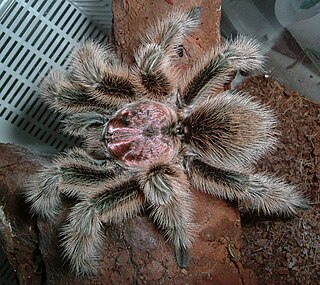
The Goliath birdeater belongs to the tarantula family Theraphosidae. Found in northern South America, it is the largest spider in the world by mass – 175 g (6.2 oz) – and body length – up to 13 cm (5.1 in) – but it is second to the giant huntsman spider by leg span. It is also called the Goliath bird-eating spider; the practice of calling theraphosids "bird-eating" derives from an early 18th-century copper engraving by Maria Sibylla Merian that shows one eating a hummingbird. Despite the spider's name, it rarely preys on birds.

Grammostola is a genus of South American tarantulas that was first described by Eugène Louis Simon in 1892. These medium- to large-sized spiders are native to tropical South America, and are usually brown in color, with pinkish or orangish-red hairs. The very docile Chilean rose tarantulas are popular as a beginner's spider among tarantula enthusiasts.

Actinopus is a genus of mygalomorph spiders in the family Actinopodidae. It was first described by Josef Anton Maximilian Perty in 1833 from the type species Actinopus tarsalis found in Brazil. The name is derived from Greek actin- "ray, beam" and pous "foot". It is a senior synonym of Aussereria, Closterochilus, Pachyloscelis, and Theragretes.

Nemesiidae, also known as funnel-web trapdoor spiders, is a family of mygalomorph spiders first described by Eugène Simon in 1889, and raised to family status in 1985. Before becoming its own family, it was considered part of "Dipluridae".

Euathlus is a genus of South American tarantulas that was first described by Anton Ausserer in 1875. It is a senior synonym of Paraphysa, and was formerly considered a senior synonym of Brachypelma, but this was later rejected.

Tarantulas comprise a group of large and often hairy spiders of the family Theraphosidae. Currently, 1,010 species have been identified. The term "tarantula" is usually used to describe members of the family Theraphosidae, although many other members of the same infraorder (Mygalomorphae) are commonly referred to as "tarantulas" or "false tarantulas". Some of the more common species have become popular in the exotic pet trade. Many New World species kept as pets have setae known as urticating hairs that can cause irritation to the skin, and in extreme cases, cause damage to the eyes.
Cyclosternum is a genus of tarantulas that was first described by Anton Ausserer in 1871.
Tmesiphantes aridai is a species of tarantula in the family Theraphosidae, subfamily Theraphosinae. The type locality is Floresta Nacional do Tapajós, Santarém, in the state of Pará, Brazil.
Tmesiphantes mutquina is a species of theraphosid spider, in the subfamily Theraphosinae. It is native to Argentina.
Tmesiphantes yupanqui is a species of spider in the subfamily Theraphosinae of the family Theraphosidae. It is endemic to Argentina.
Tmesiphantes crassifemur is a species of theraphosine theraphosid spider. It is native to Argentina.
Chaco is a genus of spider in the family Nemesiidae.
Tmesiphantes is a genus of Brazilian tarantulas in the subfamily Theraphosinae that was first described by Eugène Louis Simon in 1892. The genera Magulla and Melloleitaoina were brought into synonymy in 2019.

Kankuamo marquezi is the only species within the monotypic spider genus Kankuamo, in the family Theraphosidae. It is found in the Sierra Nevada de Santa Marta, Colombia. This spider has urticating hairs, the first to be classified as type VII. These sword-shaped, bristly hairs are used as a defense mechanism by stinging or stabbing. Most other species of tarantulas attack by throwing their hairs from a distance. Kankuamo hairs cover the entire body and have penetrating tips which will embed themselves into the skin or mucous membranes and cause severe irritation. Humans often experience mild to severe skin irritation or rashes.
Schismatothele is a genus of South American tarantulas that was first described by Ferdinand Anton Franz Karsch in 1879.
Homoeomma elegans is a species of spiders in the family Theraphosidae. It is found in Argentina.

Stormtropis is a genus of Colombian baldlegged spiders first described by C. Perafán, W. Galvis & Fernando Pérez-Miles in 2019. The genus name is in reference to the fictional stormtroopers of the Star Wars franchise.
Pablo Martín may refer to:







